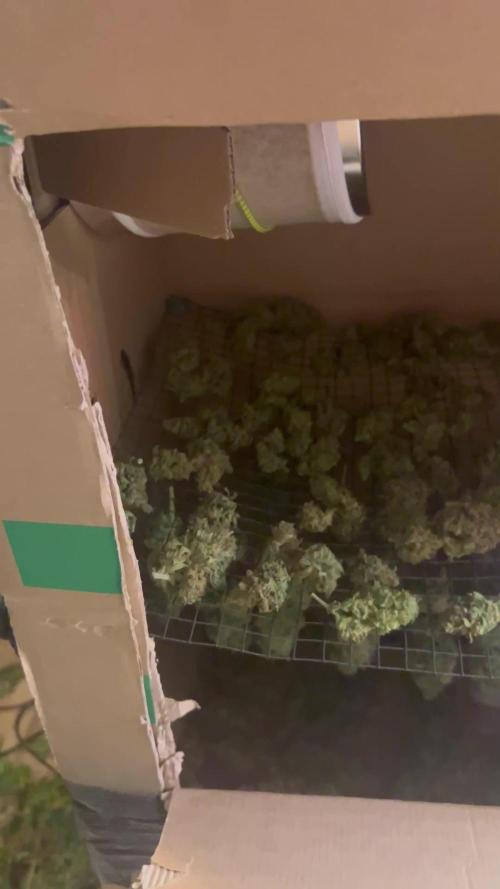The Grow Awards 2026 🏆 



























Likes
Comments
Share


@Schnabeldino
Follow
Conclusion:
Apple & Bananas from Kannabia fully delivered – 454g of wet, premium-quality buds, plus extra popcorn buds for later use. While not the largest in size, the intensity of flavor, density, and resin production make this strain a true winner.
Photos are wet buds. Once they are dry, the smoke report will follow!!!
See you again in 2-3 weeks 😇😇
Likes
91
Share


@Salokin
Follow
Hi Growmies,
So far she is developing very nicely. Had someone from the community suggest plant success orca and Rezin to me, sp these were added for the next weeks feed to prepare the pre flower. The roots have started to nest themselves right above the airstone. As of now I think I’ll give her two more weeks and then flip her, as she is stretching a bit slower than I thought she would.
Thank you all for passing by and see you next week.
Likes
48
Share


@Northern_Ent
Follow
Aug 24: cool and rainy lately but will warm up again in a couple days. Gorilla Cookies looks really good and is flowering nicely. Very nice strain. Added some soluble seaweed to the water mostly for the K.
Don’t take flash pics of photoperiods unless you’re immediately using a 730 nm light to put them into dark mode.
Using the far red light like this is known as phyto-forcing and it’s like getting an extra two hours of darkness making a 26 h day. This far north I think it moves flowering up by 3-4 weeks so obviously a huge trick. Easy and cheap if you have daily access at dusk.
Aug 26: it’s been a couple of weeks but I figured it was time for a lazy compost tea. I watered with it slightly diluted and the plants look almost immediately greener and more vigorous…amazing actually. 👍👍
Aug 27: this is definitely the fastest flowering of the four. Hopefully it stays sunny for a few more weeks. Thinned out the understory a bit as there were some small branches and bud sites that were not going to do anything.
Check out the birds sounds on the first video. The magpies thought I was too close to their nest in the tree or something…they’re usually not quite that annoying.
Aug 29: this is a great strain, and the manifold is working its magic.
Likes
12
Share


@Mr_BFL
Follow
Flush!Flush!Flush!
Fantastic smell. Moby dick like Red Grape o like that & shiskaberry like cherry jam!
Likes
12
Share


@balansa
Follow
cant beleve how strong and powerfull hilant is.she still has spidermites sh doea not have a single healthy leave but look at her how mighty she is!!! look at her trichoms!! she deffinitly will be immy next growlit!! RQS i am speechless
well now aboutthe mites i amspreyigher with neemoil and somlocal organice pesticide bacteries. i know about the neem oil in bloomingfase but i did nothave other option
so ....
happy growing and stilll thankyou RQS
Likes
43
Share


@KnightRider
Follow
Hey Cannafam,
My gals had another wet week, each day has had showers although its not been solid and she has had time to dry out in between assisted by me going out to shake off water after each rainfall. However at the beginning of the week i found what suspect to be start of rot in one of her lower braches as a sugar leaf had died for no reason amoungst a bunch of healthy ones, so that bits had the chop.
I also found a cocoon of some sort glueing to leaves together at the top of the plant and had to cut that out, the consistancy was of latex and i think it was a moths or buterfly. Needless to say ive been inspecting her dayly closley for any more issues.
On the positive side of things shes holding up quite well currently, all bud sites are building even the bottom branches which were exposed last week are starting to fill out. Smell has increased again and this gal is absolutely honkin now.
In terms of feeding shes just had one dose this week, there is a tiny bit of burn on some of her leaf tips and shes a light feeder.
The weathers looking drier for next week so she should be catchin more rays and lovin life again.
Thats all from me, thanx for stoppin by 😊💜💜💜
Likes
45
Share


@BodyByVio
Follow
Beautiful flower full of trichomes. Smell and test fantastic. Very fast flowering. She was done on day 49 but I cut her down few days later.
I love the strain, the only thing that I will like this strain to have is a better yield. Beast quality buds I ever grew.
Likes
3
Share


@factoryofweed
Follow
¡ÚLTIMA SEMANA!
Esta semana fue la última para estas preciosas 🍇PURPLE PUNCH🍇
todas han estado aumentando el peso de las flores estas dos semanas atrás, engordando hasta tal punto de doblarse enteras, tuve que agarrar dos fenotipos bastante pesados al armario.
en total estuvieron 9 semanas en floración.
De los 6 fenotipos x3 han cogido tonalidades muy bonitas como podéis ver en las fotos.
⬆️90cm
☀️Interior
⏳64 días
🏺11L
😶 Indica: 90% / Sativa: 10%
🚀THC: 25%
Likes
14
Share


@Chi_K24
Follow
Hey folks,
Hope you are all well during these pressing times... 2020 eh... so we are now into week 9 photos taken on Monday.
Recap: Late into week 8 on Friday, it was time to perform the second round of amendments this time switching it into my bloom ratio. 50-50 of gaia green 4-4-4 and 2-8-4 organic amendments. Carefully tilled it into the the first 1/4" of topsoil and watered in with molasses 50mL to 5 gal of pH 6.0 water.
Into Monday, I have spent a few hours having a brew and started to prune the ladies a bit with some selective defoliation to clean up the bushhh. Haha.
These ladies should start kicking into flower real soon since we are now halfway through August. Can't wait to see these girls stretch and begin budding! I'm hoping to stay ahead of the nutes due to it being a slow release system. I belive adding the molasass to the watering regime is supercharging thr soil. Plants haven't shown any signs of defficiencys! Happy times.
See you guys next week!
Likes
11
Share


@Growing420Dreams
Follow
En el ultimo riego con producto he bajado la dosis de A + B, he notado síntomas de sobrefertilización en una de las plantas. Se les ha aplicado defoliación quitando el 80% de hojas para facilitar que llegue la luz a los puntos más bajos.
Likes
14
Share


@Thinkingreen_420
Follow
La semana se nos complicó con algunos excesos en 4 de ellas que no aceptaron la misma cantidad de nutrientes y ya estamos regando solo con agua en su ph adecuado. Saludos!
Likes
26
Share


@Elpicor
Follow
The Canna Crumbly cocoa biscuits are always a delicious opportunity to fill up on energy. They are easy to prepare!
Ingredients:
30g Bitter Cocoa
300g flour
200g butter
100g sugar
5 eggs
1 bar of milk chocolate with whole hazelnuts
HOW TO PREPARE THE CHOCOLATE BISCUITS
1. Boil the eggs for 8 minutes, cool them and shell them.
2. Blend the egg yolks and set aside.
3. Mix the butter in a bowl with the sugar, add the flour and egg yolks, mix, then add to the mixture a bar of milk chocolate with whole hazelnuts previously blended into small pieces (I used the knife for a coarse mince)
4. Add the cocoa to half of the mixture and let them rest in the refrigerator for about half an hour.
5. At this point, roll out the pastry to about half a centimetre, then create the variegation between the two doughs (here you can have fun), once the biscuits have been formed, arrange them on a baking tray with baking paper and bake everything for 12-15 minutes at 170 degrees.
IMPORTANT: I put double the recommended dosage for the butter, thinking I was an expert smoker, but, next time I will follow the doses because I slept 12 hours, the edibles have a prodigious effect but you need to calibrate well otherwise you risk going to sleep at 8 pm!😇💤
Likes
12
Share


@Willy_Balls
Follow
So think by far the best of the bunch is one pheno of b-45. Insane structure, just the right amount of internodal spacing, huge nugs definitely bigger than golf balls. Tons of frost and very nice kush/citrus terps. Not to mention deep purple colours on the buds and the leaves despite not lowering the temps. Very curious to see what she will bring to the scales but I’m pretty sure she’s above 120g. True winner. Got her clones going and hope the clones will maintain the quality despite stress. Had some quality deterioration happen for some clones, but did my share of mistakes and learned some lessons.
I am disappointed sa far in blue Zushi form Dutch passion, very different plants. One pheno is completely like purple lemonade form fastbuds. Terps are 1:1. I like the green leaves, purple buds combo. But it’s definitely not a skittles smell.
Have a great Easter everyone. Cheers
Likes
14
Share


@Fat_Olsh_Farms
Follow
Day 35. Minor defoliation and supercropped a few branches.
Day 37. Starting to flower nicely, some frost Starting to appear on buds.
Day 41. Strong smell of strawberry bubblegum when manipulating plant.






























